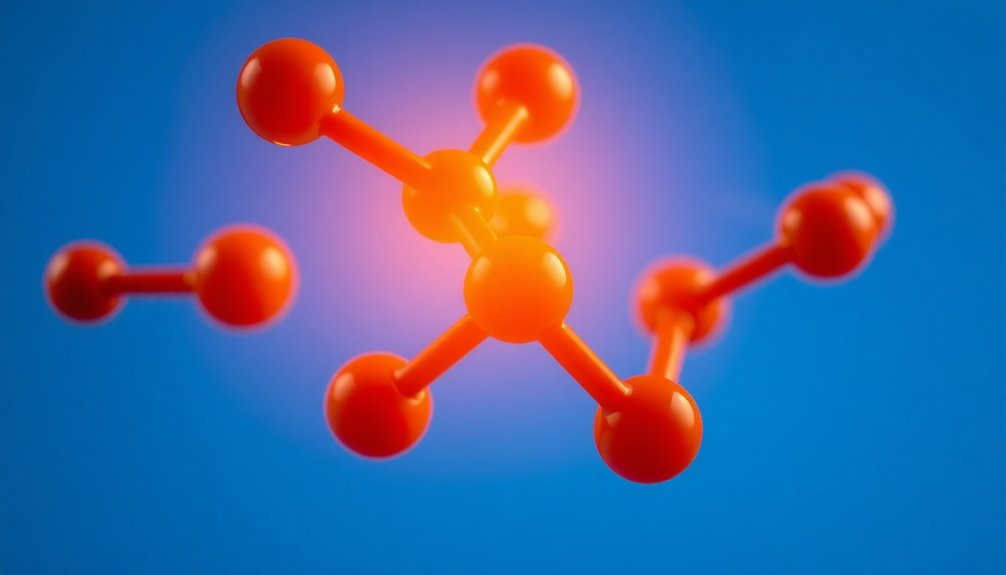Imidazole is aromatic because it fulfills the essential criteria for aromaticity. It has a five-membered, planar ring that features a fully conjugated system. According to Hückel's rule, it has six π electrons, which come from both its carbon atoms and nitrogen lone pairs. This arrangement allows for effective electron delocalization, enhancing stability through resonance. The alternating single and double bonds facilitate p orbital overlap, solidifying its aromatic character. This structure not only lowers the overall energy of the molecule but also contributes to imidazole's unique properties. You'll discover more fascinating details about its applications shortly.
Key Takeaways
- Imidazole features a cyclic, planar structure that allows for effective electron delocalization across the ring.
- It has a fully conjugated system with alternating double and single bonds, facilitating p orbital overlap.
- Imidazole contains six π electrons, satisfying Hückel's rule (4n + 2) with n = 1.
- The presence of nitrogen atoms contributes lone pairs that participate in the delocalized electron system.
- Resonance structures of imidazole enhance its stability and aromatic character, making it crucial in biological systems.
Understanding Aromaticity

Aromaticity is a key concept in understanding the stability and behavior of certain cyclic compounds. Imidazole is a prime example of an aromatic compound, as it features a planar five-membered ring with a fully conjugated system.
According to Hückel's rule, imidazole contains six π electrons, which confirms its aromatic nature. The two nitrogen atoms play a significant role, with one nitrogen contributing its lone pair to the π-electron system, enhancing resonance.
This resonance leads to the delocalization of electrons across the ring, lowering the overall energy and boosting stability. The symmetrical distribution of electron density in imidazole further contributes to its non-polar characteristics, a typical feature of aromatic compounds that you'll encounter in various chemical contexts.
Imidazole Structure Overview

Understanding imidazole's structure helps clarify its aromatic properties. This five-membered ring compound, with the formula C3H4N2, contains two nitrogen and three carbon atoms.
Its structure features alternating double and single bonds, forming a conjugated system that promotes effective p orbital overlap. Imidazole is planar, which is essential for maintaining aromaticity through electron delocalization.
The arrangement of atoms allows for six π electrons, satisfying Hückel's rule (4n + 2, where n = 1) and confirming its aromatic character. The nitrogen atoms contribute lone pairs that participate in the π-electron system, enhancing the molecule's resonance stability.
This unique structure allows imidazole to exhibit significant aromatic properties, making it an important compound in chemistry.
Hückel's Rule Explained

To determine whether a compound is aromatic, you need to evaluate Hückel's rule, which outlines specific criteria. A compound must be cyclic, planar, fully conjugated, and contain a total of 4n + 2 π electrons, where n is a non-negative integer.
Imidazole meets these requirements with its six π electrons, fitting the equation when n is set to 1 (4(1) + 2 = 6). These electrons come from three carbon atoms and the lone pairs of the two nitrogen atoms.
The delocalized π electrons within imidazole's cyclic structure lead to resonance stabilization, enhancing its aromatic character. By conforming to Hückel's rule, imidazole displays the unique stability and reactivity associated with aromatic compounds.
Resonance and Stability

While exploring imidazole's properties, you'll quickly notice how its resonance structures play an essential role in enhancing its stability. The five-membered ring contains two nitrogen atoms and six π electrons, fulfilling Hückel's rule (4n + 2). This arrangement allows for delocalization of electrons, lowering the overall energy of the molecule and making it more stable.
| Structure | Description | Stability Contribution |
|---|---|---|
| Structure 1 | Nitrogen lone pair participates | Enhances resonance stability |
| Structure 2 | Continuous p orbital overlap | Facilitates electron delocalization |
| Overall Imidazole | Two nitrogen atoms in the ring | Aromatic nature, less reactive |
Delocalized electrons result in resonance stabilization, making imidazole crucial in various biological systems.
Chemical Properties of Imidazole

Imidazole's unique chemical properties stem from its aromatic structure, which features a five-membered ring with two nitrogen atoms and three carbon atoms. Following Hückel's rule, imidazole contains six π electrons, confirming its aromatic nature and contributing to its stability through resonance.
The delocalized electrons in its conjugated π system enhance this stability, allowing imidazole to function as a weak base in various chemical reactions. Additionally, the presence of nitrogen atoms enables imidazole to form hydrogen bonds, increasing its solubility in polar solvents.
This property also makes it reactive with electrophiles and nucleophiles. Overall, imidazole's aromatic character and resonance stabilization play significant roles in its chemical properties, impacting its behavior in biological systems and reactions.
Applications in Science and Industry

Given its unique properties, imidazole finds extensive applications across various fields in science and industry.
In pharmaceuticals, it serves as a vital component in antifungal and antiviral drugs, thanks to its aromatic nature and ability to interact with biological systems.
In biochemistry, imidazole is integral to histidine, an essential amino acid that aids in enzyme catalysis.
Its effectiveness extends to coordination chemistry, where it acts as a ligand, forming stable complexes with metal ions.
As a buffering agent, imidazole maintains pH stability in laboratory and industrial processes.
Additionally, its solubility and capacity to form hydrogen bonds enhance its role in synthesizing agricultural chemicals and corrosion inhibitors, making imidazole invaluable in various industrial applications.
Frequently Asked Questions
Is an Imidazole Aromatic?
Yes, imidazole is aromatic. You can tell because it has a five-membered ring structure with a total of six π electrons, fitting Hückel's rule.
The molecule's planar shape allows for effective overlap of p orbitals, promoting electron delocalization. With two nitrogen atoms contributing to the system, imidazole exhibits resonance stability.
Its alternating single and double bonds create a conjugated system typical of aromatic compounds, reinforcing its aromatic character.
What Is the Huckel Rule for Imidazole?
If you think about Hückel's rule, it's like a magical recipe for aromatic compounds!
For imidazole, you'll find it has 6 π electrons, fitting perfectly into the formula 4n + 2, where n equals 1. This means imidazole dances in the aromatic world!
You see, it's all about that planar cyclic structure and the delightful delocalization of electrons across the ring, creating a vibrant and stable aromatic compound.
What Is the Reason for Aromatic?
Aromatic compounds are special due to their unique stability and electronic properties. They possess a cyclic, planar structure with a specific number of π electrons, following Hückel's rule (4n + 2).
This arrangement allows for electron delocalization, which lowers the molecule's energy and enhances stability. You'll find that the symmetrical distribution of electrons leads to non-polar characteristics, making these compounds less reactive and more resilient in various chemical environments.
Why Heterocyclic Compounds Are Aromatic?
Heterocyclic compounds are aromatic because they possess a cyclic structure, planarity, and a fully conjugated π-electron system.
You'll find that they follow Hückel's rule, which states they must have 4n + 2 π electrons.
The presence of heteroatoms, like nitrogen or oxygen, enhances electron density, allowing for effective delocalization.
This results in resonance stabilization, lowering energy states and increasing stability, making these compounds exhibit unique reactivity and solubility properties.
Conclusion
Just like a well-tuned orchestra, imidazole's aromatic nature harmonizes its structure and properties. By following Hückel's rule, it dances between resonance forms, showcasing stability that echoes through various applications in science and industry. As you explore the world of chemistry, remember that understanding aromaticity isn't just about formulas; it's about recognizing the beauty in molecular connections. Embrace the melody of imidazole, and you'll uncover the rhythm of countless innovations waiting to unfold.










